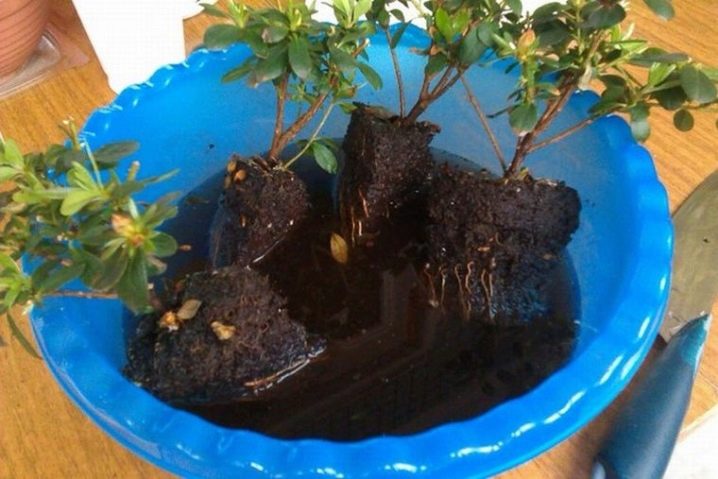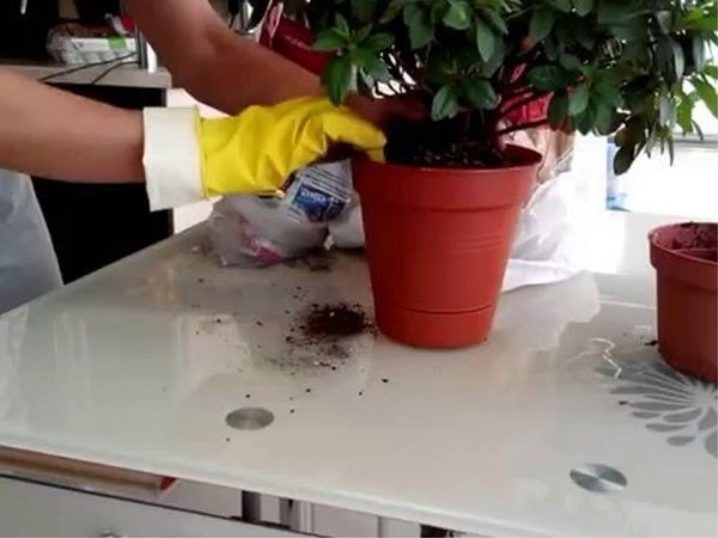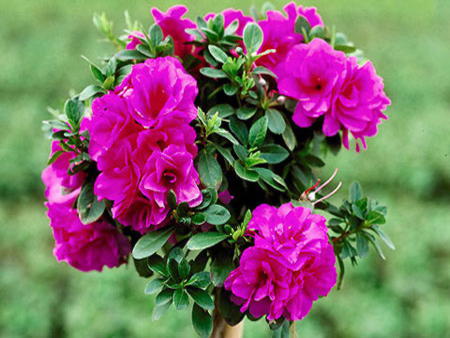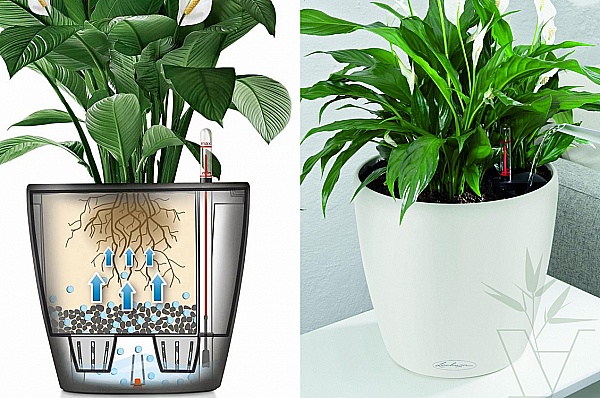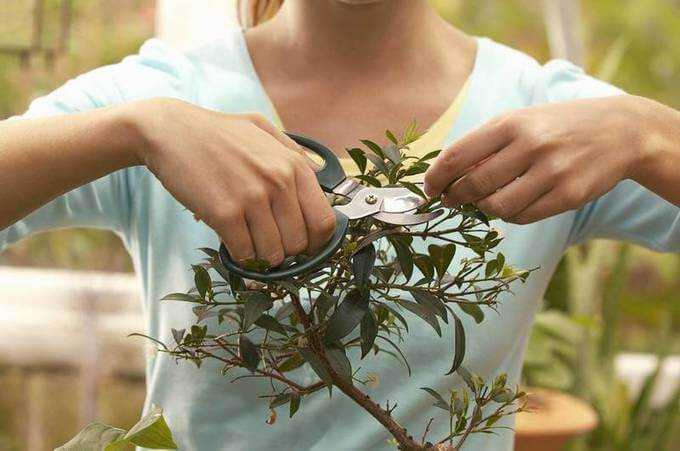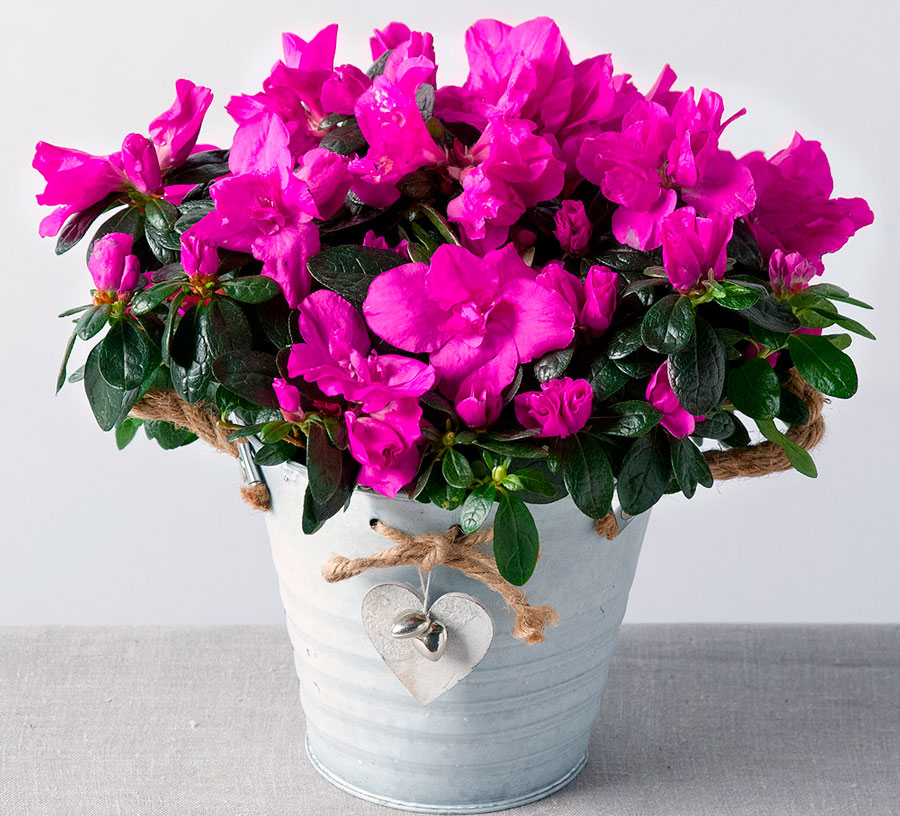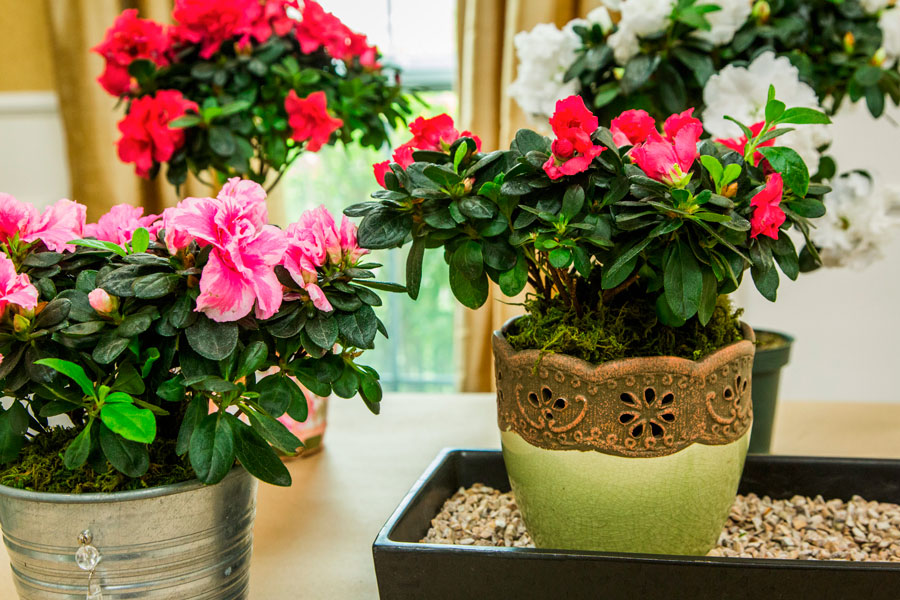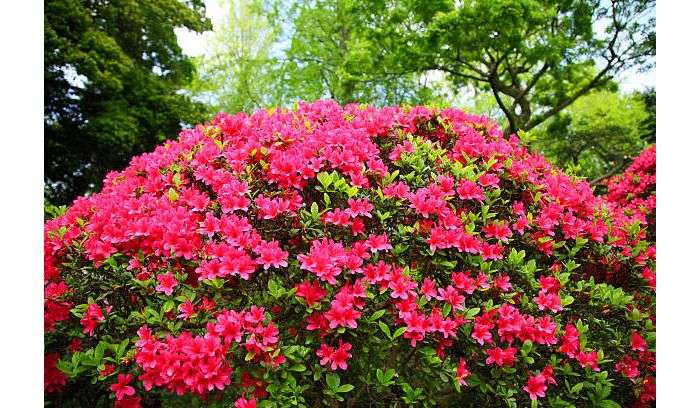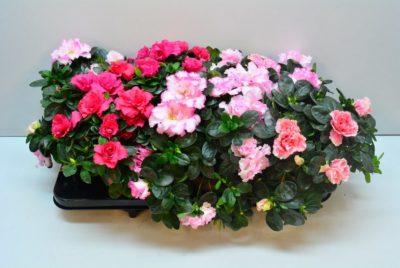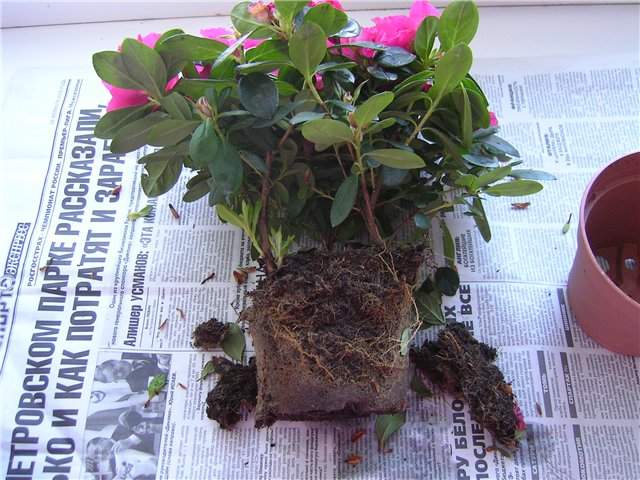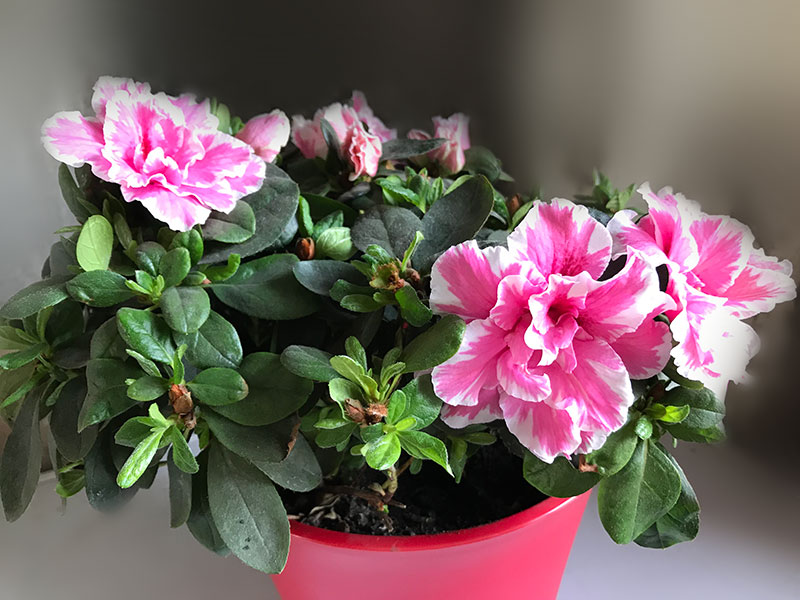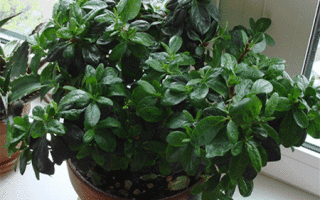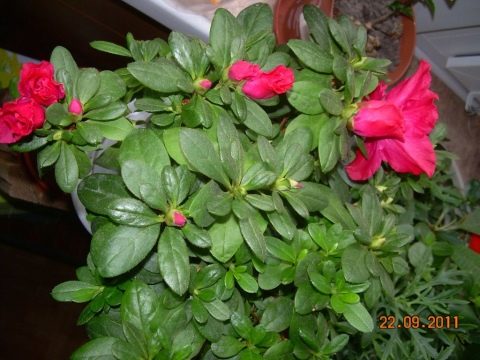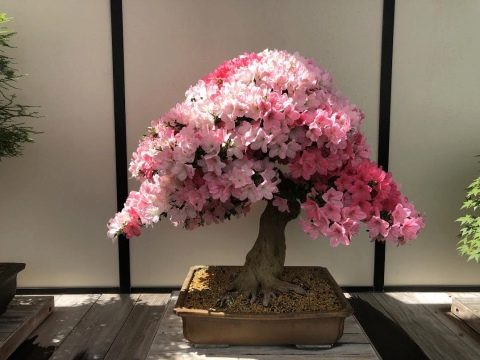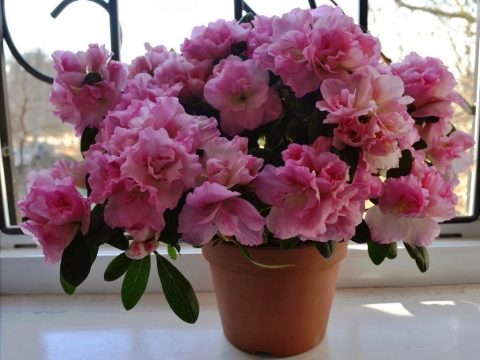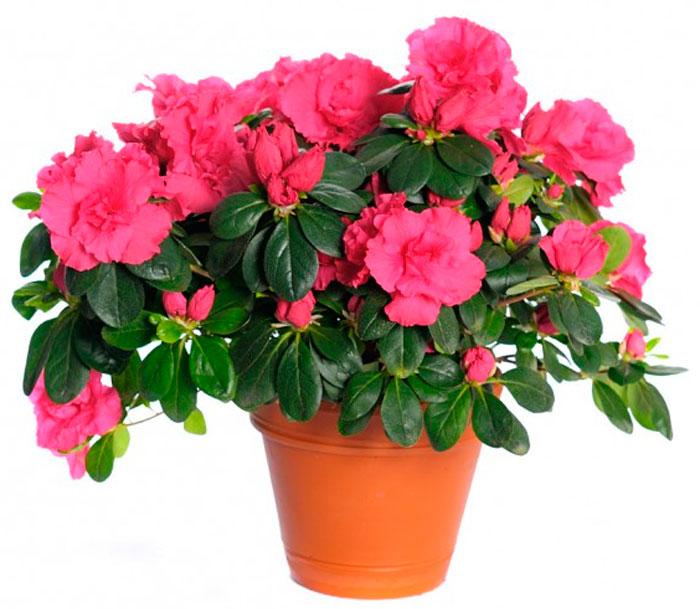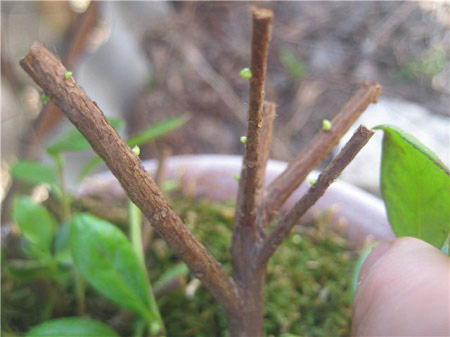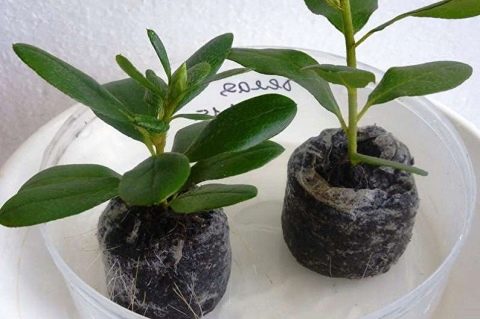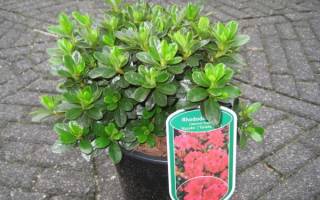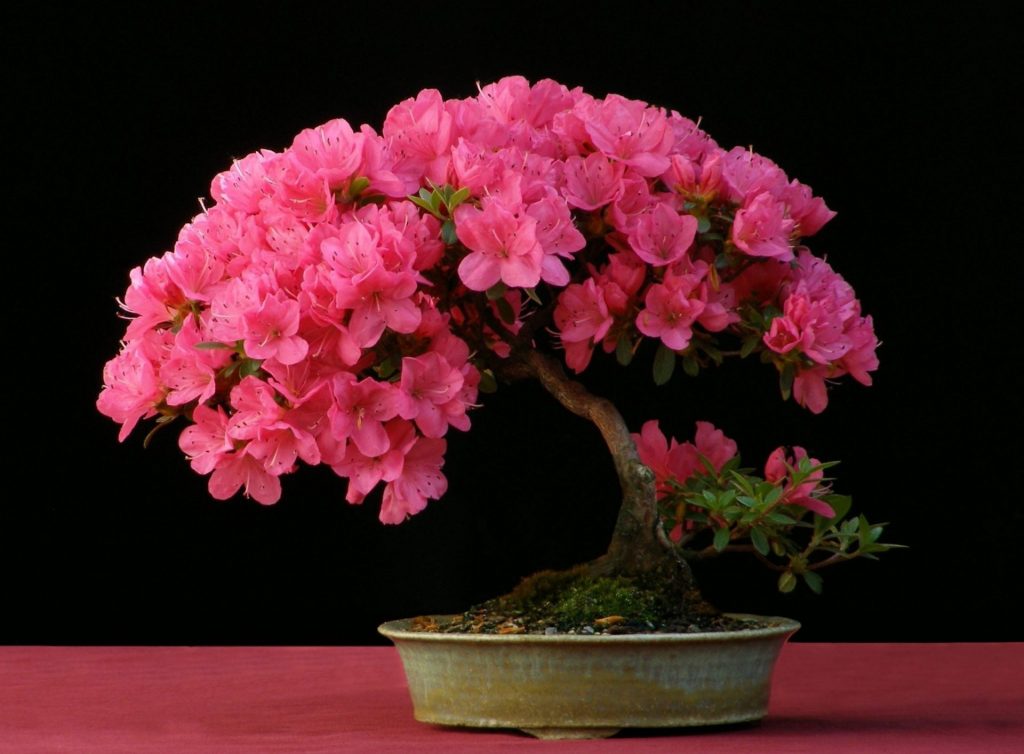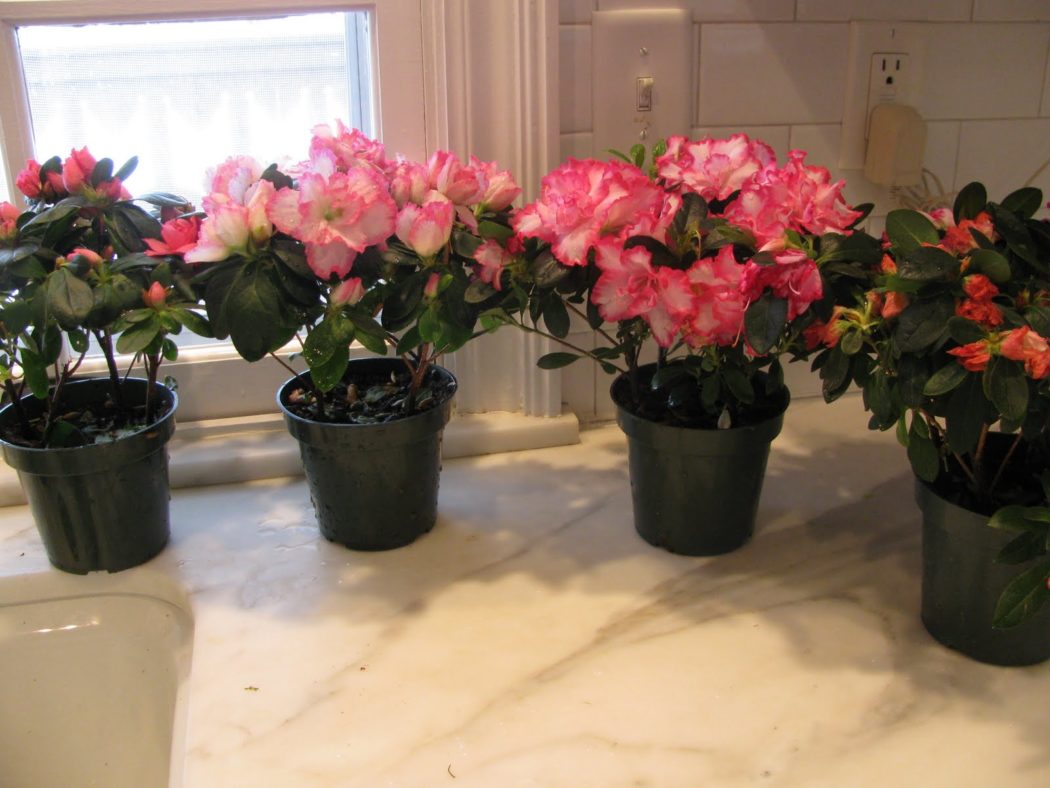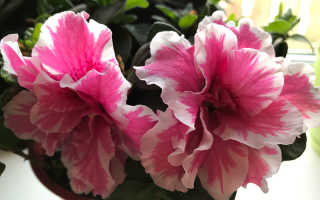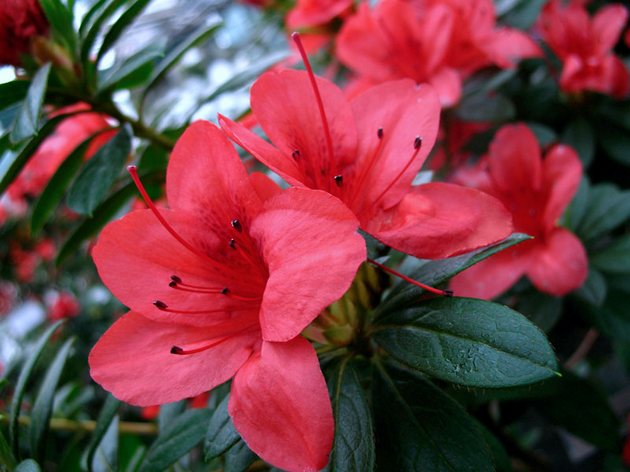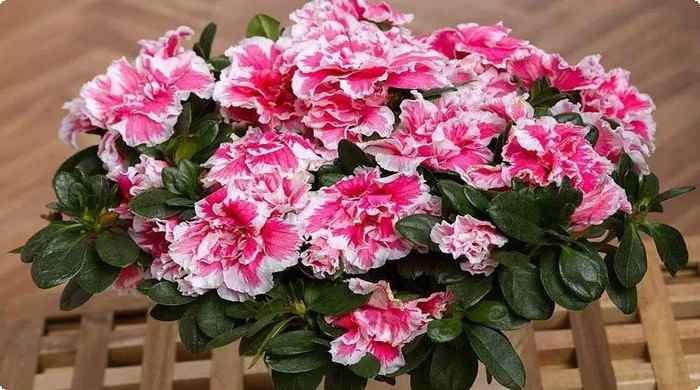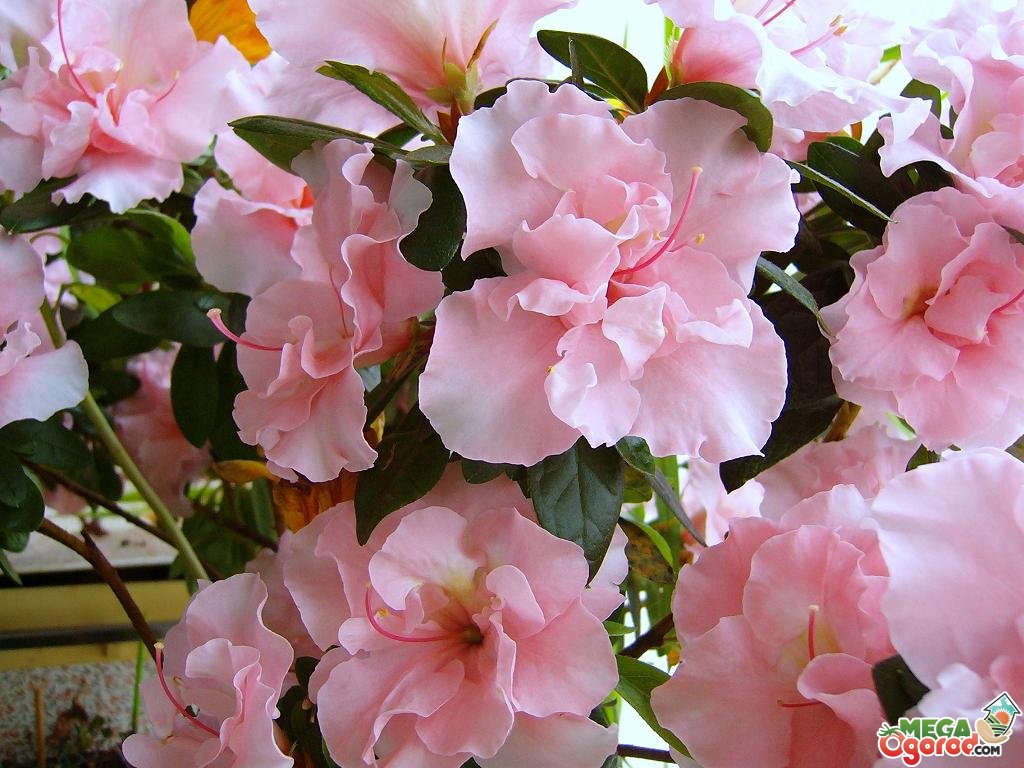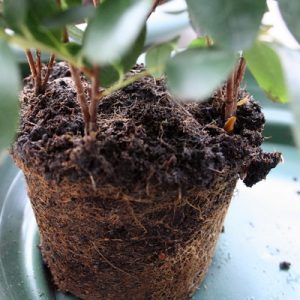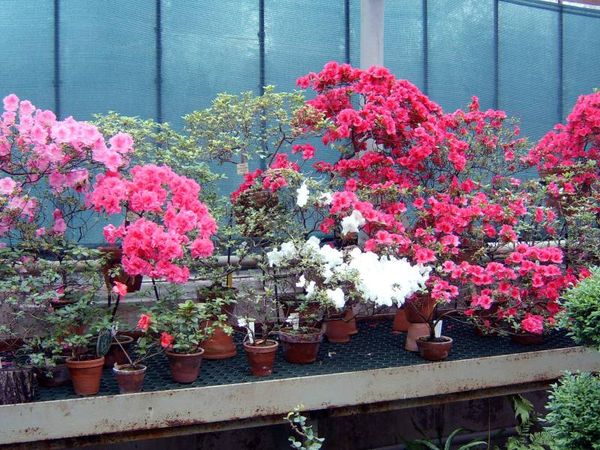Pruning azaleas in the garden
The plant begins spring with already formed flower buds, therefore, after wintering, only sanitary pruning of azaleas is carried out in the garden, when dry and diseased shoots are removed.
The formation of a shrub is carried out after the flowers have wilted. During the procedure, both dry peduncles and overly elongated branches are cut off. If you do not remove attention from pruning azaleas for several years, the bush gradually overgrows, the shoots block the access of light and air, which leads to the development of diseases and insect pests.
Young shrubs up to 3 years of age can not be formed, carrying out only the removal of dead shoots.
How to properly transplant azalea indoors
Before planting the azalea, preparatory work is carried out. For this you will need:
- Sharp knife or secateurs.
- Alcohol for tool processing.
- Purchased or self-prepared soil.
- Planting capacity.
Selection and preparation of soil
How to transplant a cactus: options at home
If for some reason it is not possible to purchase a special substrate for azaleas, prepare it yourself. To do this, mix:
- finely chopped pine bark;
- pre-well dried sphagnum;
- perlite or vermiculite;
- sifted river sand;
- coal;
- nutritious soil.
All components are thoroughly mixed. Before planting, the resulting substrate is treated with a disinfectant.
On a note! One of the drugs is added to the final mixture: root or trichodermin.
Pot selection
A wide container is suitable for planting. The size of the new pot is adjusted according to the size of the root system. A planter is ideal for azaleas.
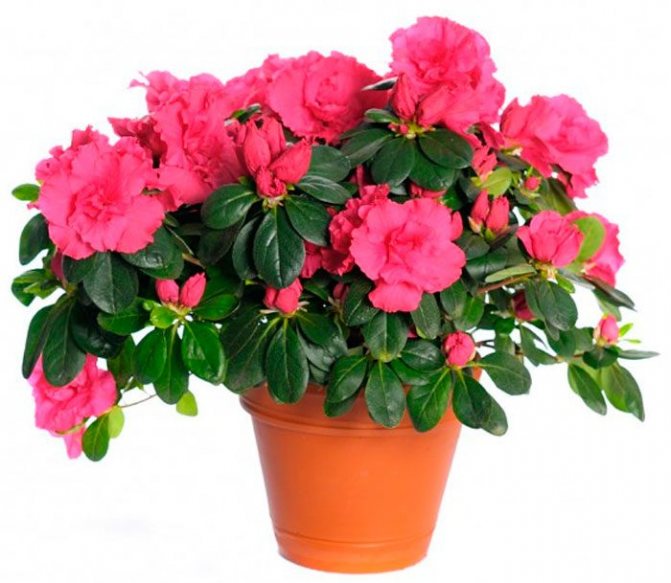
Transplant capacity
Renewal root pruning
Sanitary root pruning has a beneficial effect on the plant. The flower, together with an earthen lump, is taken out of the pot. Initially, external damage is examined and dead parts are removed. It is not recommended to separate a dense earthen lump with your hands, this can lead to damage to weak roots. Before pruning, soak it in a mixture of warm water and Zircon. After this, they begin to renewal pruning. The roots are cut on each side by 1-1.5 cm.
Splitting an azalea
The division of the bush is carried out not only for reproduction of the species you like, but also due to the large size of the plant
To do this, carefully take the flower out of the pot, examine the root system and, as necessary, cut off diseased or dried parts. The earthen ball is cut with a knife into several parts.
Important! At least one shoot remains on each section. Each new plant needs its own individual pot
Planting in another pot
The planting procedure consists of a number of step-by-step activities:
The bottom of the container is covered with drainage by 3 cm.
The next layer is chips or crushed moss.
To prevent decay, sprinkle with any antifungal agent.
The soil composition is covered with very little, only to carefully distribute the root system over the planting container.
The roots of the pre-soaked azalea are lightly squeezed out.
The flower is placed exactly in the center of the pot and carefully covered with soil.
It is not recommended to deepen the root collar of the plant, this can damage it and will not allow it to develop normally.
The substrate is lightly tamped.
Watering after planting is carried out with the same composition in which the soaking was carried out.

Overgrown root system
Note! Azalea should not be watered abundantly after planting.This can lead to rotting of the roots first, and then the whole flower.
Azalea transplant
A regular transplant of azaleas is carried out when the mass flowering is completed. Such a measure will not only not damage the culture, but will also help to renew it, give it strength and lay the foundations for further growth.
In this case, the procedure carried out in relation to indoor rhododendrons has its own characteristics. First of all, you should be very careful about the root system of the shrub.
When the azalea is carefully removed from the pot, the grower most often finds a dense, black-brown sponge-like earthen lump. It is completely penetrated by many large and small roots, and traces of salts and dead tissue can be seen on the remaining fragments of the soil. Therefore, the transplant of azaleas is always preceded by treatment, including:
- removal of the remnants of the old substrate;
- renewing root pruning;
- treatment of the root system with a growth stimulator and zircon.
Due to the excessive density of the root system inside the pot, the azalea loses some of its nutrients, and the access of moisture and oxygen deteriorates. To remedy the situation, a lump with azalea roots is cut off about a centimeter from the bottom, at the root collar and along the lateral surface. Along the way, soil residues are removed.
In this form, the azalea flower is placed in a container with clean warm water, into which, according to the instructions, a root system growth stimulator and zircon, which has an immunomodulatory and fungicidal effect, are added. While the florist is preparing a nutritious soil mixture, the roots of the azalea will be saturated with moisture, and stimulating drugs will show their effect.
Unlike many houseplants, azaleas prefer to grow in acidic soil. Therefore, the mixture is specially prepared for them. To do this, take:
- specialized soil for azaleas;
- chopped steamed bark;
- sand;
- dried sphagnum moss;
- charcoal;
- perlite and vermiculite.
On this topic:
BACK
FORWARD
1 of 2
- A small layer of substrate is poured onto expanded clay.
- An azalea flower is installed in the center of the container, around which fresh soil is gradually poured so that the root collar of the bush is not affected.
- The substrate is compacted and after transplanting the azalea is lightly watered with a solution in which its root system has been soaked.
The best place for a shrub after the procedure is a well-lit window, but not in direct sunlight, where the plant is not threatened by drafts, and there are no heating devices nearby.
In the following 3-4 days after transplanting the azaleas, the soil is not moistened, and then watering is gradually resumed using filtered or settled water at room temperature. Within 1-2 months, the plant must undergo acclimatization and replace the loss of the root system.
Care and landing
After purchasing the plant, it is important to create suitable conditions for the azaleas. It is advisable not to carry the flower along the street without packaging, which must be removed only at home no earlier than half an hour later.
For 2-3 weeks, the azaleas need to be dormant, not placed near other plants or transplanted. It is best to place the pot in partial shade and maintain the required moisture level in the soil and foliage.
Adaptation period
After the azalea has rested, the plant begins to adapt to new conditions. This is a fairly lengthy process that ends only at the end of the first flowering. During habituation, the bush is especially sensitive to moisture, refreshment, temperature and nutrients:
- the room must be cool;
- the plant does not need additional fertilizers;
- the humidity level should not be low;
- for the formation of immunity, biostimulants can be used in small doses.
Lighting
Bright sunlight is detrimental to the condition of the azalea. Direct rays should be muted, but not eliminated completely. Partial shade or low natural light conditions are best.In case of thick clouds, the azalea can be taken out onto the balcony or terrace; in this case, you can not be afraid of summer rains. In the south, the flower can be grown in the open field, placing it in the shade of trees and shrubs. In this case, the plant needs mandatory protection from possible frosts.

Temperature
For a full-fledged growing season, it is advisable to provide the azalea with the amount of heat appropriate for the season. The peculiarity of the plant is that the flowering corresponds to the winter period. At this time, an ambient temperature of 18-20 ° C is suitable for the bush. In summer, the air in the room should not be warmed up more than 23 ° C, and the flower itself should not be placed near air conditioners. In the fall, the plant is in the process of laying buds for next year, at this time the azaleas need a low temperature, about 12 ° C.
Humidity
A high moisture index is necessary for azaleas to grow fully. To maintain this indicator you need:
- spray the bush during flowering;
- put the pot in a deep tray filled with water and pebbles;
- with a close location of heating devices, increase the frequency of spraying the plant;
- use a spray bottle with the smallest holes.
How to water
Watering the azalea should be vigorous, but not excessive. The most suitable moisturizing schedule is once every 2 days. In the fall, the period of watering the plant can be shortened.
The flower tends to leach the soil in which it grows, so from time to time you can add a little citric acid to the water for irrigation.
Water requirements
Water suitable for irrigating azaleas should have the following characteristics:
- temperature is equal to or higher than room temperature;
- no impurities, for this you can boil the water in advance or use rain and melt water after settling.

Soil composition
Azalea, unlike most houseplants, prefers acidified soil. Therefore, the flower pot must be filled with one of the soil options:
- special substrate for azaleas;
- land suitable for heather;
- homemade soil mixture from coniferous and peat land in a 2: 1 ratio with the addition of a small amount of clean river sand;
- use hydroponics.
Pinching and trimming
Regular pruning helps to form the crown, and pinching of the shoots helps to increase the number of flowers. Over time, the flower can be turned into a compact bush or a small, luxuriantly flowering tree. It is necessary to trim the azalea very carefully, exactly following the rules:
- Use only special garden tools.
- Do not prune the plant the first time until May.
- Re-pruning is carried out only after the appearance of buds.
- Cut off thick and undersized branches.
- Remove flowers one at a time after flowering.
New young shoots must be pinched in order for buds to form and flowering to be more lush.
After flowering
At the end of flowering, it is necessary to prepare the plant for the dormant period:
- Remove dried inflorescences.
- Remove too long and thin stems.
- Pinch young branches.
- Healthy cut shoots can be rooted.
- Apply fertilizers with a high nitrogen content.

7 general rules for caring for azaleas
Azalea has quite rightly earned a reputation as a very capricious plant. Its cultivation is associated with a lot of nuances that must be constantly remembered. However, most of them can be boiled down to a number of general rules:
- Good lighting out of direct sunlight. It is necessary to position the azaleas so that the sun illuminates them at a certain angle or through a light barrier. If the windows face south, it is better to place the plant pot slightly away from the windowsill. Too bright lighting results in shorter flowering times and leaf burns. Too scarce - to stop growth and discard leaves.
- Moderately cool content. Azaleas do not like high air temperatures very much. In the reference book by D.Hession points out that the optimal temperature range for this plant is from +10 to + 15C. In fact, azaleas feel fine even at temperatures around + 22-23C. Keeping at a low temperature is strictly necessary only after flowering.
- High air humidity. In nature, rhododendrons grow in regions with a humid climate, and indoor cultivars have inherited a love of high humidity. In apartments with dry air, azaleas will bloom for a very short time and shed their buds.
- Moderate but constant soil moisture. A number of sources indicate that the soil under the azaleas should be not just wet, but moist. However, practice shows that this plant is susceptible to root diseases due to the bay. Therefore, the irrigation regime should be regular but prudent. The soil should be kept slightly moist while ensuring good drainage.
- High acidity of the soil. Like tall rhododendrons, which grow only on acidic soils, azaleas get sick when planted in standard neutralized soil mixtures. The soil hydrogen index for azaleas should not exceed 4.5 units.
- Mandatory trimming. This procedure is necessary not only to keep the crown of the plant in shape, but also to stimulate flowering. Azaleas that are not pruned do not bloom well and look unkempt.
- Top dressing with the right fertilizers. Since azaleas react very painfully to changes in soil acidity, it is necessary to approach the selection of fertilizers for them responsibly. You cannot use all kinds of universal formulations recommended for all plants at once. Only specialized drugs are required.
If you remember these simple rules and apply them when growing an azalea, it will be much easier to preserve this plant for many years:
Subject to the rules of agricultural technology, the azalea bush lives in room conditions for 7-9 years.
Views
Azalea has many varieties, which differ in the area of growth, appearance, color and shape of the buds. In ornamental gardening, the Indian and Japanese varieties are distinguished, as well as some hybrids.

Indian
Indian azalea can be distinguished by the following features:
- the need to limit the roots and pruning the crown;
- height 0.4-0.5 m;
- large size of flowers;
- variegated color of petals with specks and edging.
Japanese
Characteristic features of the Japanese azalea:
- height up to 0.5 m;
- dense crown shape;
- small buds of mauve color;
- unpretentiousness.
Deciduous
Deciduous azalea is most commonly used in landscaping and is planted outdoors. Typical features of the bushes:
- height 0.5-1 m;
- large flowers are collected in large inflorescences and have a rich palette;
- glossy small leaves change color in autumn and partially fall off;
- slow growth in the early years;
- high resistance to diseases and pests;
- unpretentious care;
- the ability to survive light frost.
Full transplant
From April to the end of summer, it is possible to transplant the azalea to propagate. Any of the options requires painstaking work. A flower grower can get young plants using cuttings, seeds and the method of dividing the bush.
Also, they are engaged in transplanting some time after the purchase of a new flower. When the plant has faded, it needs to be allocated a new container for growing. And then, over time, it will again turn into a gorgeous tree, the foliage of which is not visible under the flowers.
The procedure is performed only once and fully. Compliance with the rules will help the plant grow quickly and well. Every year they are exclusively engaged in transshipment of plants in order to increase the volume of the planting capacity. And only if several bushes grow in the pot, they should be planted. Thickening interferes. And diseases that threaten the health of the root system can be transferred from one shrub to another.In addition, a stronger plant can interfere with others.
Young blooms need a transplant once a year, adults - once every 24 - 36 months. They are engaged in transshipment not only when the pot has become small, but also if unforeseen circumstances have occurred.
To plant and even handle an azalea, you should know what it looks like and what to do with a clod of earth that is on the roots. So, a lump should be like a sponge in a healthy plant. You can neither shake it off nor clean it
Thin roots, often on the surface, can only be cut with a sharp knife and with great care
And this greatly interferes with division.
It must be remembered that this rhododendron needs the safety and presence of its own microflora of the root system. It must be the same throughout the life of the plant. And if the azalea is deprived of this microflora, the shrub may even die.
Azalea care
Azalea care at home after purchase is considered by many growers to be an easy task. But, unlike other flowers, azalea requires some peculiarities in the content.
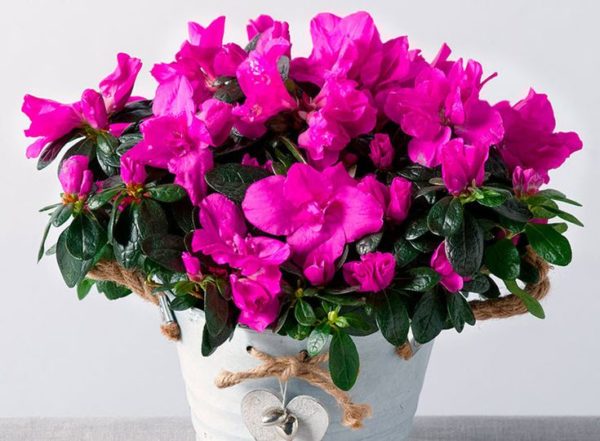
Location and illumination
Azalea does not tolerate direct sunlight - diffused light on the eastern windows will be very useful. You can create a small partial shade by covering the flower with lutrasil from the side of the windows. Or place a large plant in front of it to shade the space.
Temperature regime
The optimal condition for the growth of azaleas is considered to be 17-21 degrees. In winter, the temperature is reduced to 10-15 degrees.

What land
Special soils are selected for the plant, taking into account the natural growing conditions. Azaleas like slightly acidic ground. This soil can be purchased from a gardening center. Sometimes they take a substrate for heather, hydrangea or conifers.
Frequency and degree of watering
Frequent watering is carried out only when the topsoil dries up. Water is taken cool, at room temperature. Although azalea loves cold, its root system can die from too cold liquid. Waterlogging is also detrimental to the bush.
Fertilization
Since azalea is an evergreen shrub, feeding is carried out constantly, about once every 14 days. While the plant is developing, nitrogenous additives are added under it, when the first buds appear, they are replaced with superphosphate or Bud. You can also buy a special azalea food.
Pay attention! Sometimes they get by with improvised means, for example, you can add lemon juice by diluting it in water.
Sanitary and formative pruning
After all the flowers have fallen off, the seed pods, broken twigs, remaining buds, and thickening are removed.
After about six months, you can do formative pruning, give a special shape to the bush. So that the azalea can bloom for a long time and does not waste energy, the already wilted flowers must be removed.
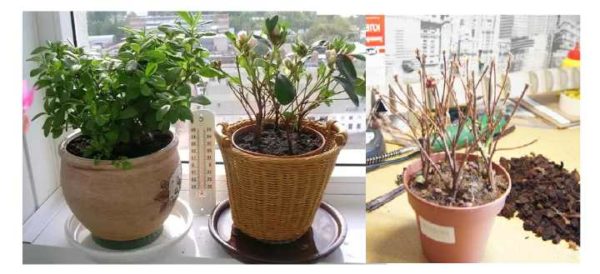
When transplanted
Azalea does not like this. But if you have just brought a flower after purchase, you need to do so after about 7 days to ensure that the plant is properly cared for at home.
If the shrub is in bloom, they are waiting for the end of flowering. Then prepare the pot. It should be 3 cm wider than the previous one. Drainage is placed in the container.

Prepared land is taken. It is best to handle the azalea with an earthen lump. After the soil has been covered, the plant is well watered.
Transplant features
When growing azaleas for sale on farms, chemical stimulants are used. Shrubs, planted in cardboard cups with a small amount of peat mixture, are treated with a synthetic substance called a retardant, which puts them into hibernation. In addition to them, fertilizing with prolonged action is added to the soil, thereby maintaining a blooming and fresh appearance of the azalea for two to three months.

With this approach to cultivation, buds are obtained even on small shoots, but the roots and leaves do not develop.After purchase, flower growers do not use these preparations.
So that the azalea does not die in a couple of weeks, and the root system develops normally, it is transplanted at home, but after a period of adaptation. In this case, do not wait until she drops the buds. Some of the blossoming corollas and buds are cut off, and then the flower is transferred to a new substrate. Otherwise, he will experience severe and irreparable stress. For the same reason, a transplant is carried out in the future after flowering.
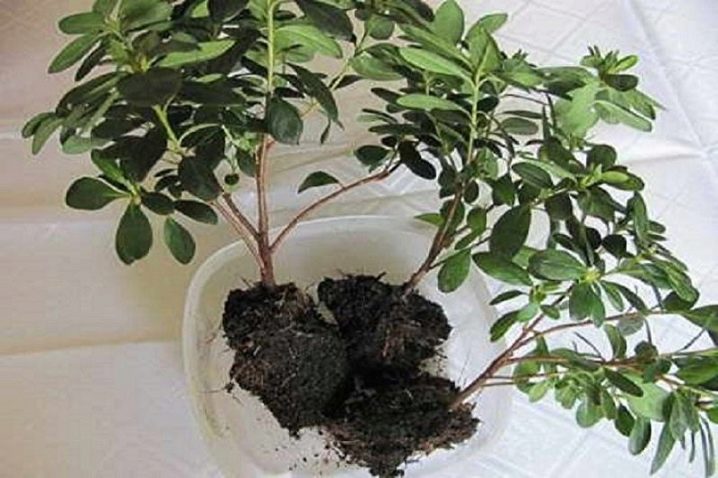
Experienced growers do not transplant a flower in winter due to the fact that it is dormant. All natural processes are inhibited in him. The right time for transplanting is the resumption of vegetation processes. The best way is to transfer the flower to new soil.
The growth and appearance of buds on azaleas depend on how meticulously the grower prepared for the transplant.
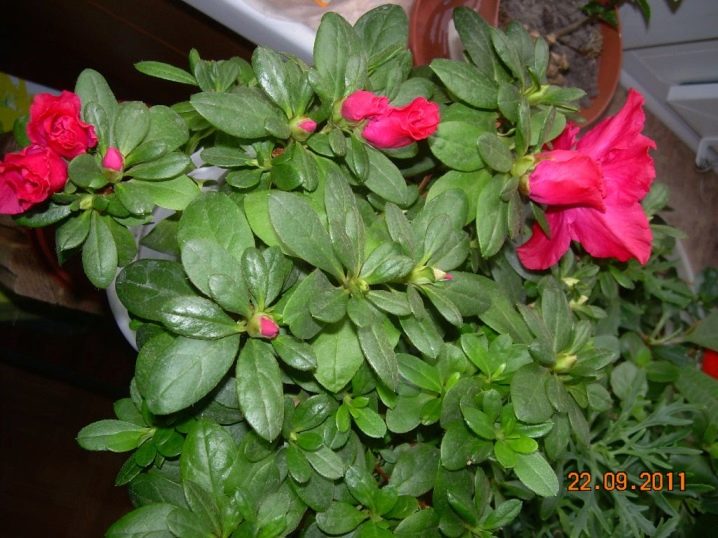
The optimum level of soil acidity for azaleas is 3.5-5.5 pH. There are two ways to prepare it: buying ready-made soil for azalea in a flower shop and preparing the substrate yourself.
Ready soil
Newcomers to floriculture transplant the azalea into store-bought soil: Fasco, Udmurttorf or Permagrobusiness. This method of transplanting is safe for a flower, but on condition that coniferous earth is present in the composition, among other components. Ready soil for azaleas has all the necessary components for healthy root development and flowering
Carefully study the label before buying. If the composition of the substrate includes a complex of trace elements and minerals, do not fertilize the flower for 2-3 months after transplanting. This potting mix is suitable for an adult plant. Young or vegetatively propagated flowers are planted in a land where nutrients are scarce.
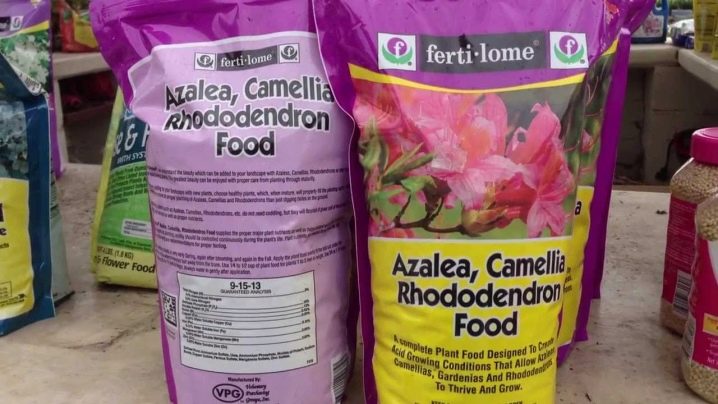
The date of manufacture is recognized by the inscriptions on the label. This information will not hurt if the grower buys soil for future use: the fresher it is, the better.
DIY soil preparation
Experienced flower growers plant the azalea in the soil mixture prepared on their own. It must be crumbly to allow air to pass to the root system. There are three recipes for good soil:
- 1 part of sand and peat, 2 parts of coniferous land;
- 1 part of sand and deciduous humus, 2 parts of humus from fallen needles of spruce, fir, larch, pine and 3 parts of peat collected during the decomposition of sphagnum or cotton grass moss with the participation of moisture;
- in equal proportions, take special soil for azaleas, sphagnum moss, steamed bark, vermiculite, charcoal, perlite.

Whichever method of preparation of the substrate you choose, before transplanting, all unnecessary things (twigs, pebbles, pieces of polyethylene) are removed from it and disinfected. To do this, use "Fitosporin", fry it in the oven or steamed in a water bath for 30 minutes with occasional stirring. Without disinfecting it, they are faced with the defeat of the plant by pests and fungal diseases.
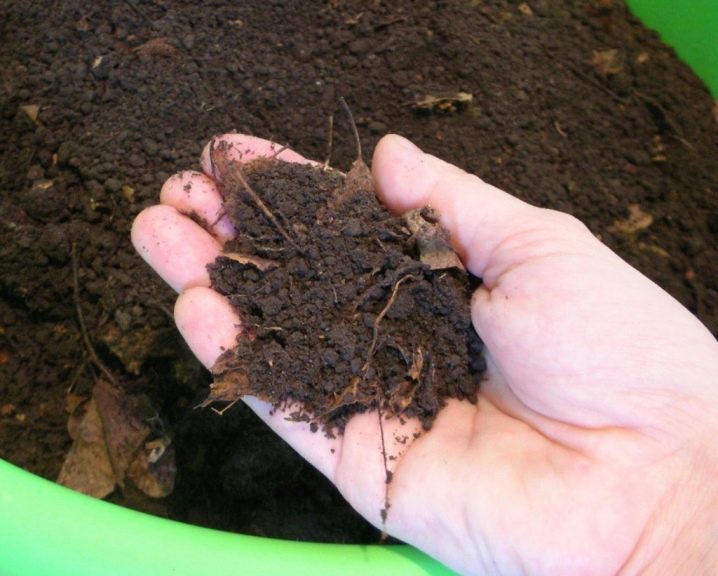
Choose it according to the size of the root system. It should be wider and larger than the previous one.
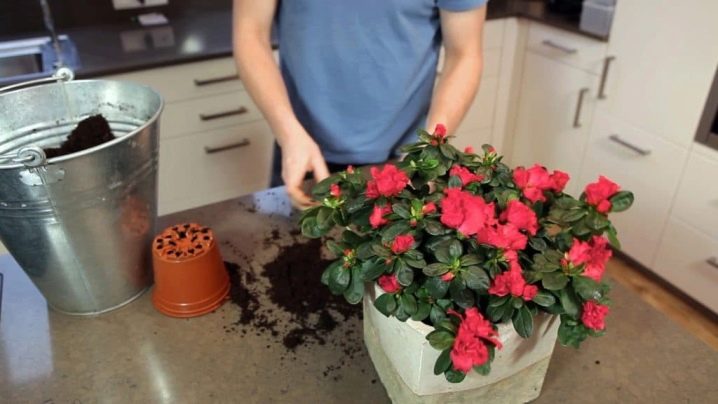
Step-by-step instruction
In order for the azalea to take root in a new place and not dry out, transplant it in accordance with the sequence below.



